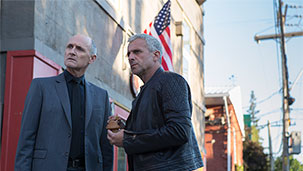What makes a film genuinely Canadian? People cite all sorts of common clichés, or get all bureaucratic and claim it’s the producer’s passport. But I’d like to share one that I’ve long held to be true: Canadian films don’t end in crane shots.
Having seen more than 500 Canadian films, it’s something I’ve often noticed. The crane shot, aside from boasting big production value, signals to the viewer that it’s okay to leave the story now—everything’s going to be fine! Crane shots are the cinematic equivalent of “they all lived happily ever after,” or, when they start a film, the equivalent of “once upon a time.” Two tropes which are so very un-Canadian, don’t you think?
Maybe that’s why Bon Cop Bad Cop 2, which aspires to be both uber-Canadian and American-esque, ends with an entire crane sequence. Characters, cars, and cameras all get their turn riding the big boy in the climax. It struck me as both cheeky and appropriate.
The last Bon Cop Bad Cop film was a fairy tale in itself, after all. Billed as the first truly bilingual film in the country, it went on to be the most successful homegrown movie in Canadian history. It seemed inevitable that there would be a sequel, but it has taken more than a decade for David Bouchard and David Ward to re-team. The time between has seen the men noticeably age, but also grow more comfortable in their roles. Colm Feore, in particular, has found subtle ways of infusing more comedy into his straight-laced persona. Patrick Huard (who also wrote the screenplay) unveils a more emotional centre to his Martin Riggs-inspired rogue cop. In both cases, it’s never anything short of terrific when the two of them are together.
The look of the sequel has also changed drastically. Whereas Bon Cop Bad Cop’s director Erik Canuel aimed to parallel David Fincher’s aesthetics and desaturated colour pallette, director Alain Desrocher is clearly more influenced by the Fast and the Furious films (which makes sense, after his hit film Nitro). The film opens at a car rally to the sound of July Talk’s “Push + Pull” – and of course that smooth, possibly crane-assisted camera movement through the rows of show cars – before turning into a (modest) chase on the Décarie. Whether by design or by necessity (hint: it’s both), character is always at the forefront, which makes the action sequences feel secondary, but never second rate.
Bon Cop Bad Cop 2 is a welcome change of pace from what we typically see in theatres—even if the film, a decade later, now has to compete with an extremely elevated level of television production (most notably the I-can’t-believe-I-like-this-show-so-much Lethal Weapon series). Sweeping crane shots, after all, are no longer just the domain of feature films. But when you know what you’re doing with them, and when people are clearly having fun on both sides of the screen, size really doesn’t matter.
Sincerely,

Christopher







